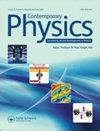Bionanomaterials for environmental and agricultural applications
IF 3.3
4区 物理与天体物理
Q2 PHYSICS, MULTIDISCIPLINARY
引用次数: 0
Abstract
The title of this book captured my interest immediately and the summary of chapter headings looked very promising. Over the years I have lectured on the applications of nanotechnology and mostly with respect to the impacts on humans in terms of safety, diagnostics and therapy, and one of the surprises for me, has been the relative neglect for the impact on plants. This is compounded by the importance of plants for food and the environment and the fact that plants grow in soils which have a very high percentage ofmicro and nanoparticles, and they contribute to aerosol particles in the air. I have also emphasised to my students that looking for effects of nanoparticles on plant cells does not require the expensive and strict regulatory protocols that are required for animals and humans! Despite all of this, there is a shortage of textbooks to help the interested reader and I hoped that this volume would fill this gap. The book is very nicely produced, and it is readable, with very extensive references for each of the 14 chapters. A descriptive style has been adopted which requires hardly any detailed prior knowledge of physics, chemistry ormathematics. However, herein lies the biggest shortcoming: there is a lack of rigour and also a lack of critical analysis. Of the 14 chapters there is some considerable overlap between them which could have been avoided. There are two on biosensors and that topic is repeated in other chapters. However, the treatment is rather superficial and lacks good explanation of the main science behind the sensor function and measurement. There are three chapters on wastewater treatment using nanomaterials and another two on environmental remediation, all with strong overlaps. There is hardly any quantification as to the valence state of toxic metals and the concentrations that occur, apart from one table which does not employ comparable units. Although they refer to World Health Organisation and the US Environment Protection Agency guidelines, there are no actual references to where these are published. Bionanocomposites are in two main chapters and are referred to elsewhere in the book. The treatment is very descriptive, withmany references, but there is no underlying structure to the presentation.Other chapters cover antimicrobial aspects of metals and their oxides as well as pesticide control, fertilisers and growth enhancement. Opportunities have been missed for discussion as to why some of the nanoparticles show antimicrobial properties. There is a separate chapter on the impact of bionanomaterials on the food industry. This is rather brief and again there is inconsistency in the use of units. Concentrations of analytes vary between grams per litre and molar concentrations and there are no definitive references to the regulations by different agencies. To be fair, much of the book will stimulate interest to those who are very new to the field of nanotechnology. So, what is missing? There is nothing on the aspects of soil and the processes that occur in the root region and uptake of water and nutrients or unwanted nano-toxins by plants. There is nothing about the detailed photosynthesis, respiration and transpiration that occurs in leaves, along with the uptake and emission of gases and the effect of nanomaterials. These omissions detract from the value. The editors expressed the hope that this book will serve as a textbook for students and perform a reference function for professionals, scientists, researchers and academics. I fear that this is overoptimistic, but it has many useful attributes.用于环境和农业应用的生物纳米材料
这本书的标题立刻引起了我的兴趣,章节标题的总结看起来很有希望。多年来,我一直在讲纳米技术的应用,主要是关于纳米技术在安全、诊断和治疗方面对人类的影响,令我惊讶的是,人们相对忽视了纳米技术对植物的影响。植物对食物和环境的重要性,以及植物生长在含有很高比例的微粒子和纳米粒子的土壤中的事实,使这种情况更加复杂,而这些微粒子和纳米粒子会导致空气中的气溶胶颗粒。我还向我的学生强调,寻找纳米颗粒对植物细胞的影响并不需要像对动物和人类那样昂贵和严格的监管协议!尽管如此,能够帮助感兴趣的读者的教科书还是很短缺,我希望这本书能填补这一空白。这本书制作得非常好,可读性强,14章中的每一章都有非常广泛的参考资料。采用了一种描述风格,几乎不需要任何详细的物理、化学或数学知识。然而,这里存在着最大的缺点:缺乏严谨,也缺乏批判性的分析。在14章中,它们之间有相当多的重叠,这是可以避免的。有两章是关于生物传感器的,这个主题在其他章节中重复。然而,这种处理是相当肤浅的,缺乏对传感器功能和测量背后的主要科学的很好的解释。有三章是关于使用纳米材料处理废水的,另外两章是关于环境修复的,所有这些都有很强的重叠。除了一张没有采用可比单位的表格外,几乎没有任何关于有毒金属的价态和发生的浓度的量化。虽然他们提到了世界卫生组织和美国环境保护署的指导方针,但并没有实际提及这些指南的出版地点。生物纳米复合材料分为两个主要章节,并在本书的其他地方提到。治疗是非常描述性的,有许多参考文献,但没有基本的结构来表示。其他章节涵盖金属及其氧化物的抗菌方面以及农药控制,肥料和生长促进。关于为什么一些纳米颗粒表现出抗菌特性的讨论已经错过了机会。有一个单独的章节是关于生物纳米材料对食品工业的影响。这是相当简短的,在单位的使用上又有不一致的地方。分析物的浓度在克每升和摩尔浓度之间变化,不同机构对法规没有明确的参考。公平地说,这本书的大部分内容将激发那些对纳米技术领域非常陌生的人的兴趣。那么,缺少了什么呢?关于土壤和发生在根部区域的过程以及植物对水和养分或有害纳米毒素的吸收方面没有任何内容。书中没有详细描述树叶中的光合作用、呼吸作用和蒸腾作用,以及气体的吸收和排放以及纳米材料的作用。这些遗漏降低了价值。编者表示,希望这本书能成为学生的教科书,并为专业人士、科学家、研究人员和学者发挥参考作用。我担心这是过于乐观的,但它有许多有用的属性。
本文章由计算机程序翻译,如有差异,请以英文原文为准。
求助全文
约1分钟内获得全文
求助全文
来源期刊

Contemporary Physics
物理-物理:综合
CiteScore
2.90
自引率
5.00%
发文量
18
审稿时长
>12 weeks
期刊介绍:
Contemporary Physics presents authoritative and lucid introductory review articles on important recent developments in physics. The articles are specially commissioned from experts in their field. The authors aim to review comprehensively the current state of their subject and place it within a broader context of contemporary research, industrial possibilities and applications in an accessible way.
The Journal is of particular use to undergraduates, teachers and lecturers and those starting postgraduate studies who wish to be introduced to a new area. Readers should be able to understand the review without reference to other material, although authors provide a full set of references so that those who wish to explore further can do so. The reviews can also be profitably read by all those who wish to keep abreast of the fields outside their own, or who need an accessible introduction to a new area.
Articles are written for a wide range of readers, whether they be physicists, physical scientists or engineers employed in higher education, teaching, industry or government.
Contemporary Physics also contains a major section devoted to standard book reviews and essay reviews which review books in the context of the general aspects of a field.
 求助内容:
求助内容: 应助结果提醒方式:
应助结果提醒方式:


